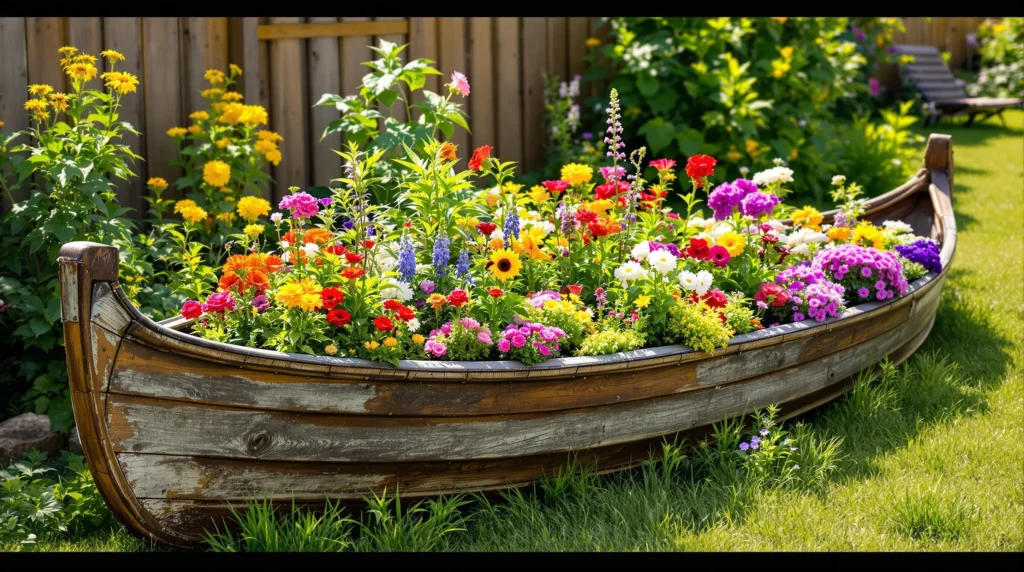10 Creative Garden Ideas for Repurposing Old Boats
1. Elevated Flower Bed
Transform your old rowboat into a stunning raised flower bed by filling it with quality soil and your favorite blooms. Position it as a centerpiece in your garden where the curved hull creates natural drainage. For best results, drill a few small holes in the bottom to prevent waterlogging and line the interior with industry fabric before adding soil.
2. Herb Garden Container
Convert a small dinghy into a productive herb garden that combines beauty with functionality. The compartmentalized nature of boats works perfectly for separating different herbs that might otherwise compete for space. Install the boat near your kitchen door for easy access when cooking, and use the boat’s natural contours to create microclimates for sun-loving herbs like rosemary and shade-preferring mint.
3. Pond or Water Feature
Use the natural water-holding properties of a boat to create a charming garden pond. Seal any holes, line the interior with pond liner, and add aquatic plants like water lilies and lotus. Enhance the feature with a small pump to create a gentle fountain effect, attracting birds and beneficial insects to your garden.
4. Vertical Garden Wall
Stand a boat upright and secure it firmly to create an unexpected vertical planting space. Attach planting pockets or small containers to the boat’s interior and fill with cascading plants like ivy, petunias, or strawberries. This approach works especially well with narrow boats or canoes where the slim profile creates a dramatic garden element without taking up too much ground space.
5. Garden Shed or Tool Storage
Larger boats like fishing skiffs can be converted into charming garden storage answers. Add a simple roof structure, install shelving inside, and use it to store gardening tools, pots, and supplies. The boat’s existing compartments offer natural organization options while keeping everything protected from the elements.
6. Children’s Play Area
Create a magical play space by anchoring a boat in a sandy area of your garden. Fill the bottom with sand to create a nautical-themed sandbox, or add cushions and weather-resistant fabrics for a reading nook. This repurposed boat offers endless opportunities for imaginative play while serving as a unique garden feature.
7. Wildlife Habitat
Transform your old boat into a sanctuary for local wildlife by filling different sections with materials that attract various creatures. Add bird houses, insect hotels, and native plantings to create a biodiversity hub in your garden. Position it in a quiet corner where animals can feel secure while you can still observe the visiting wildlife.
8. Succulent Display
The shallow draft and multiple compartments of small boats make them ideal containers for drought-tolerant succulent gardens. Fill with well-draining cactus soil and arrange a collection of colorful succulents and cacti for a low-maintenance display. The boat’s elevated position showcases the intricate patterns and textures of these fascinating plants.
9. Outdoor Bar or Serving Station
Convert a boat into an entertaining station for your garden parties. Add a flat surface across the top to create a serving area, and use the boat’s interior for storage of beverages and supplies. For added charm, install solar-powered string lights around the perimeter to illuminate evening gatherings.
10. Portable Kitchen Garden
Create a productive vegetable garden in a medium-sized boat that can be moved to follow the sun throughout the seasons. Install wheels on the bottom for easy repositioning and fill with rich compost for growing seasonal vegetables. The mobility allows you to optimize growing conditions while adding an element of flexibility to your garden design.
Transforming Wooden Rowboats into Raised Garden Beds
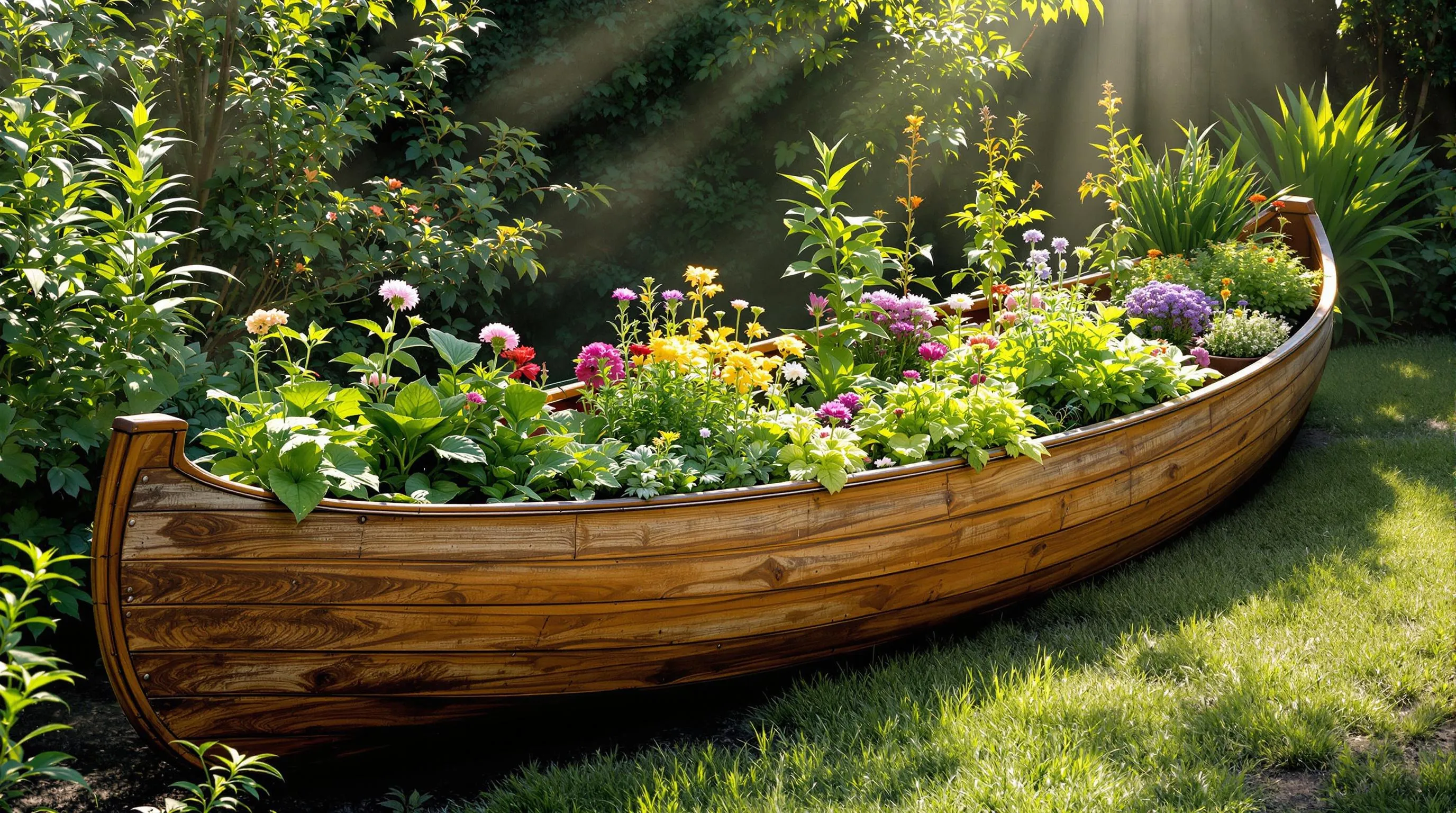
Wooden rowboats make perfect raised garden beds, combining rustic charm with practical functionality. Their elongated shape provides ample planting space while their elevated design reduces back strain during gardening activities. Plus, repurposing an old boat adds a unique focal point to your industry that tells a story.
Selecting the Right Boat for Your Garden Space
Choose a rowboat that matches your garden’s scale and style. Smaller boats (6-8 feet) work well in cozy gardens or patios, while larger vessels (10-12 feet) make dramatic statements in spacious yards. Look for boats with intact hulls to prevent soil leakage, though minor cracks can be repaired. Cedar, cypress, or oak boats are ideal due to their natural rot resistance. Consider the boat’s placement carefully—position it where it receives appropriate sunlight for your intended plants and serves as a visual anchor in your garden design.
Preparing Your Boat for Planting
Start by thoroughly cleaning your wooden rowboat with a mild detergent and water solution to remove dirt, algae, and potential contaminants. Drill several 1/2-inch drainage holes along the bottom, spacing them every 12 inches to prevent waterlogging. Apply a non-toxic wood preservative to extend the boat’s lifespan while keeping plants safe. Line the interior with industry fabric to contain soil while allowing water drainage. Add a 2-inch layer of gravel at the bottom for improved drainage, followed by a quality potting mix enriched with compost. Consider installing a simple irrigation system using soaker hoses to maintain consistent moisture levels throughout your unique raised bed.
Creating a Stunning Canoe Flower Display
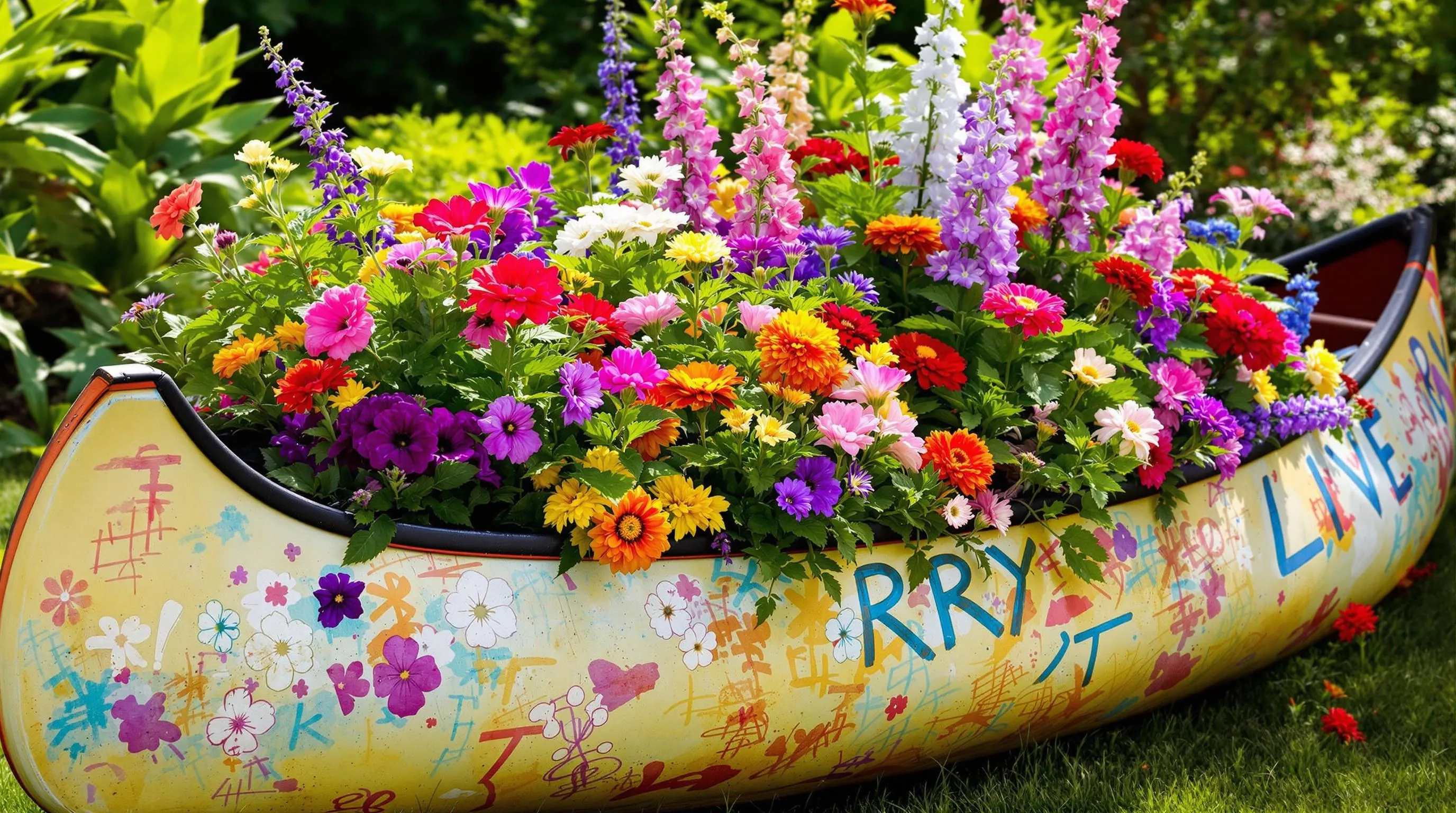
Transform an old canoe into a breathtaking flower display that will become the centerpiece of your garden. Canoes offer the perfect elongated shape for creating dramatic floral arrangements that draw the eye across your industry. Their natural curves and weathered patina add instant character while providing ample planting space.
Best Flowers for Canoe Gardens
When selecting plants for your canoe garden, choose varieties that complement its unique shape and create visual interest. Trailing plants like creeping jenny, ivy, and petunias work beautifully along the edges, cascading over the sides to soften the boat’s lines. For height and drama, incorporate vertical bloomers such as delphiniums, foxgloves, or ornamental grasses toward the center. Mix in colorful annuals like marigolds, zinnias, and cosmos for continuous color, or opt for perennials like coneflowers, black-eyed Susans, and daylilies for year-after-year beauty. Consider using a “thriller, filler, spiller” approach—place tall statement plants in the middle, fill the main area with medium-sized bloomers, and let trailing varieties spill over the edges for a professional-looking display.
Drainage Answers for Boat Planters
Proper drainage is crucial for the success of your canoe garden. Start by drilling several 1/2-inch holes along the bottom of the canoe, spacing them about 6-8 inches apart to allow excess water to escape. Add a 2-inch layer of gravel or broken pottery pieces at the bottom before adding soil to improve drainage and prevent holes from clogging. For wooden canoes, line the interior with industry fabric to slow deterioration while still allowing water to drain. Consider elevating one end of the canoe slightly to encourage water flow toward the drainage holes. During particularly rainy periods, check that water isn’t pooling in any sections and add additional drainage holes if necessary. This simple preparation ensures your stunning floral display thrives throughout the growing season.
Designing a Sailboat Herb Garden
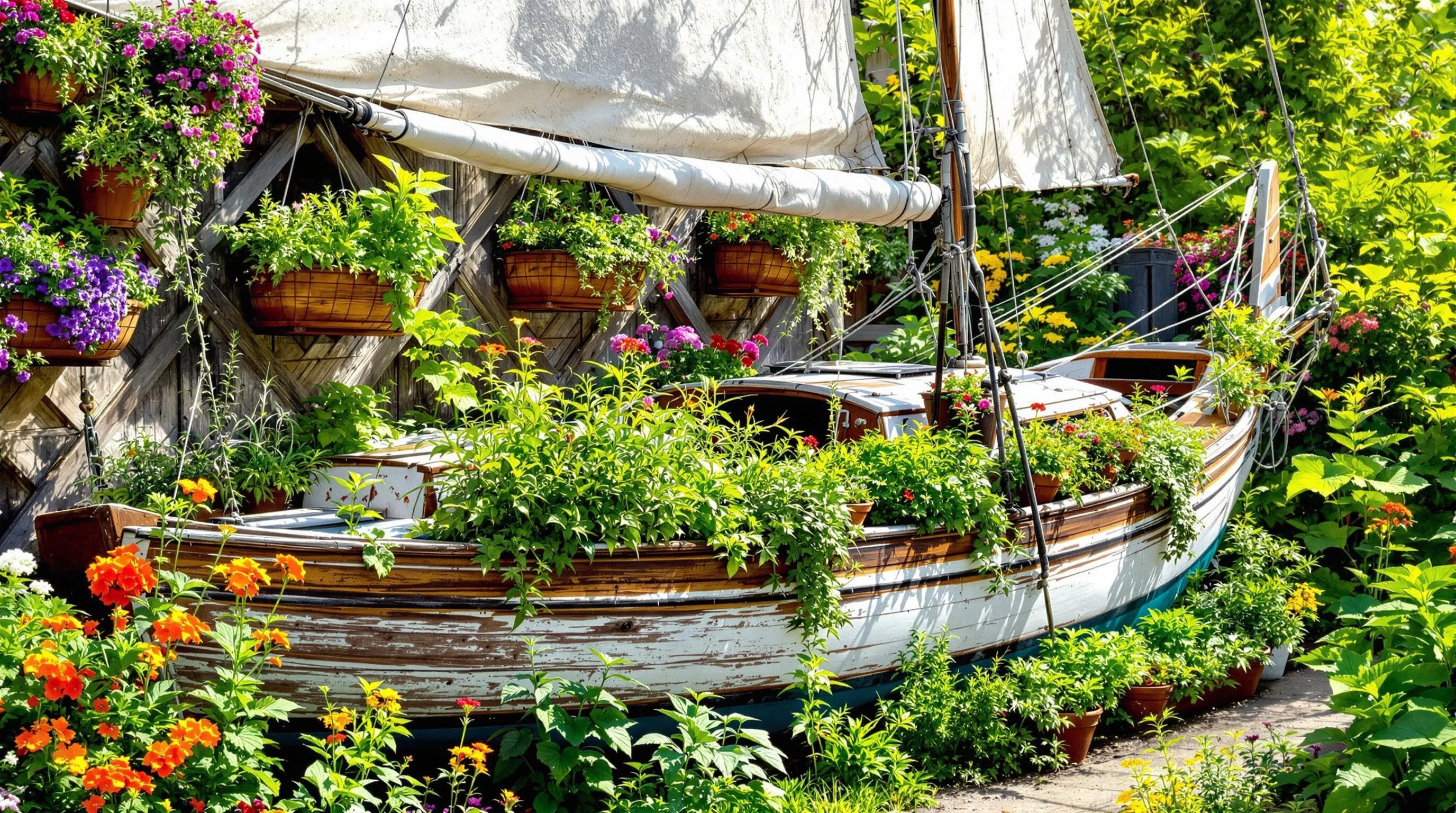
Sailboats offer unique opportunities for herb gardens with their distinctive structure and built-in features. The combination of a weathered sailboat hull with fresh herbs creates a striking visual contrast while providing practical growing space for culinary and medicinal plants.
Vertical Growing Options Using the Mast
Transform your sailboat’s mast into a vertical herb garden by attaching tiered planters or hanging containers at different heights. Install horizontal crossbars on the mast to create multiple planting levels, maximizing your growing space. Small fabric pouches or repurposed gutters can be mounted to the mast, creating a space-efficient herb tower. For a more artistic approach, wrap plant-filled rope netting around the mast, allowing trailing herbs like thyme and oregano to cascade downward. The height advantage of the mast also provides excellent sun exposure for light-loving herbs while creating a unique focal point in your garden industry.
Weather-Resistant Herbs for Boat Gardens
Select herbs that can withstand variable conditions to thrive in your sailboat garden. Mediterranean herbs like rosemary, thyme, sage, and lavender excel in this environment as they naturally prefer well-drained soil and can handle fluctuating moisture levels. Maritime herbs such as sea kale and samphire are particularly appropriate choices, given their natural coastal habitat. Plant mint varieties in contained sections of your boat garden as they spread aggressively and can overtake other herbs. Hardy perennials like chives and winter savory provide year-round interest, while nasturtiums add edible flowers that complement the nautical aesthetic. Position these resilient herbs strategically within your sailboat, placing sun-lovers toward the bow where exposure is typically greatest.
Building a Children’s Play Area from an Old Dinghy
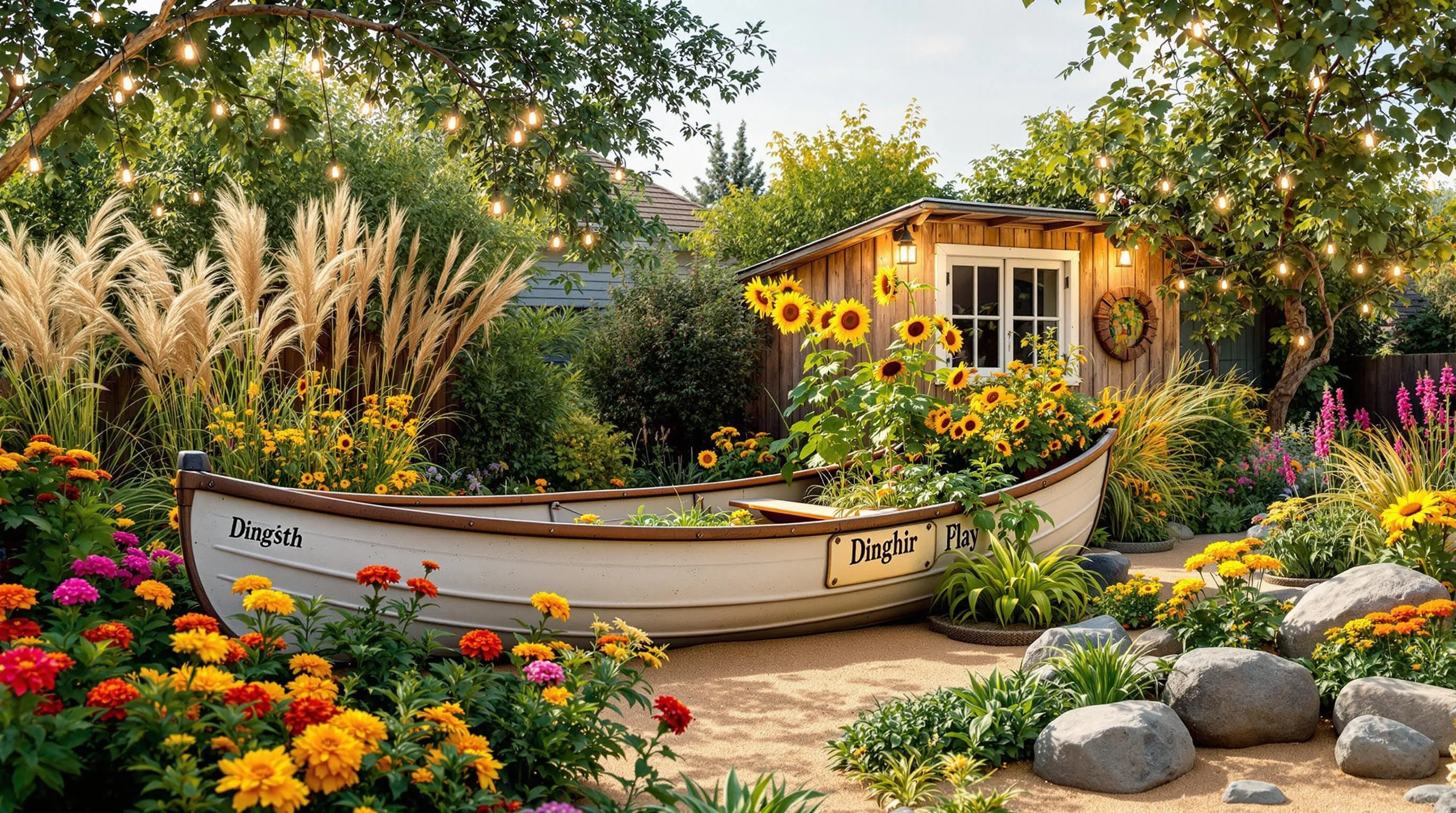
Transform an old dinghy into a magical play area that’ll spark your children’s imagination while adding whimsical charm to your garden. A repurposed boat creates a unique playground that stands out from standard play equipment and encourages creative outdoor play.
Safety Considerations for Boat Play Spaces
Safety must be your top priority when converting a boat into a children’s play area. Start by thoroughly sanding all surfaces to remove splinters and rough edges, paying special attention to gunwales and seating areas where children will frequently touch. Apply non-toxic, weather-resistant paint to seal the wood and prevent deterioration. Secure the boat firmly to the ground using concrete footings or heavy-duty ground anchors to eliminate tipping hazards. Install soft landing surfaces around the boat such as rubber mulch, sand, or specialized playground chips with a depth of at least 8-12 inches. Remove any hardware that poses pinching or catching hazards, including cleats, rusty nails, and damaged parts. Consider adding drainage holes to prevent water accumulation, which can create slipping hazards and accelerate rot. Finally, regularly inspect your boat play area for signs of wear, splinters, or structural weaknesses to maintain a safe play environment.
Themed Garden Elements to Complement Your Boat Play Area
Enhance your boat play area with complementary garden elements that create an immersive maritime adventure. Plant tall ornamental grasses around the boat to simulate water waves, using varieties like blue fescue or pampas grass that sway in the breeze. Create a beach-themed sandbox adjacent to the boat using fine play sand bordered by smooth river rocks or driftwood. Add nautical-themed accessories such as a ship’s wheel, telescope, or recycled buoys to encourage imaginative play. Install weather-resistant storage inside the boat to house toys and outdoor games. Plant resilient, child-friendly flowers like marigolds or sunflowers in strategic spots to add color without creating maintenance challenges. Consider establishing a pathway of stepping stones leading to the boat, perhaps shaped like sea creatures or shells. For added magic, incorporate solar-powered fairy lights along the boat’s edges to create an enchanting atmosphere during evening hours. These thoughtful additions will transform your repurposed dinghy into the centerpiece of a cohesive, adventure-filled garden space that children will love exploring.
Crafting a Unique Pond Feature from a Fiberglass Hull
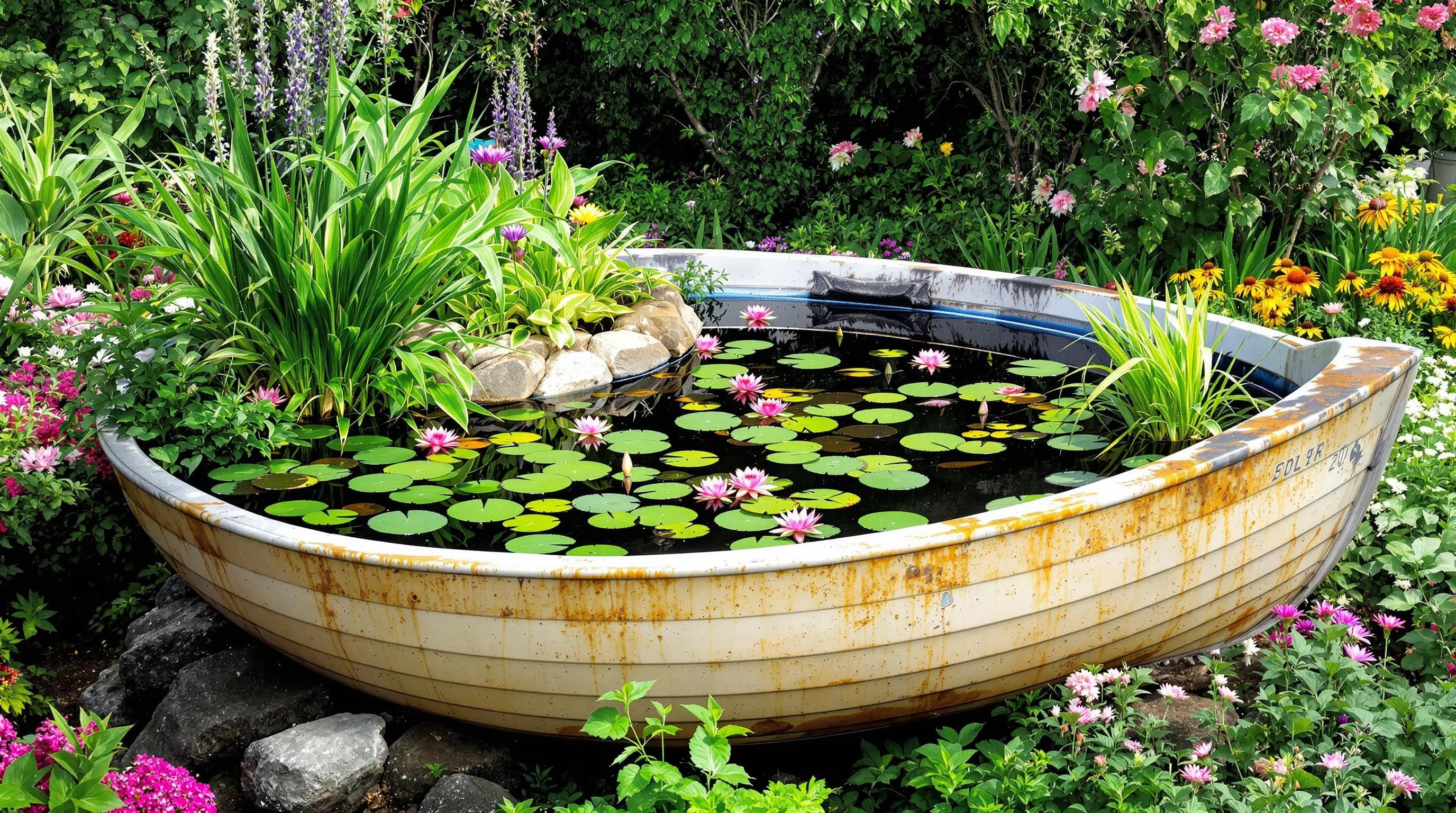
Fiberglass boat hulls make exceptional pond features due to their natural water resistance and durability. Unlike wooden vessels that may deteriorate over time, fiberglass hulls are already designed to withstand constant water exposure, making them ideal candidates for conversion into garden water features. You’ll find that fiberglass boats maintain their structural integrity for years while creating a distinctive focal point in your industry design.
Installing Proper Waterproofing and Filtration
To transform your fiberglass hull into a functioning pond, you’ll need to address any existing damage first. Inspect the hull thoroughly for cracks or holes and repair them using marine-grade epoxy or fiberglass repair kits. While fiberglass is naturally waterproof, applying an additional waterproof sealant to the interior provides extra protection against leaks. For proper water circulation, install a submersible pump (40-100 gallons per hour capacity for small hulls) and position it at the deepest point. Add a basic filtration system with biological, mechanical, and chemical components to maintain water clarity and quality. Consider incorporating a small fountain or waterfall feature by running tubing from the pump to the boat’s edge, creating both visual interest and beneficial water aeration that prevents stagnation and algae buildup.
Selecting Aquatic Plants for Your Boat Pond
Choose a diverse mix of aquatic plants to create a balanced network in your boat pond. Include floating plants like water lilies (Nymphaea) or water lettuce (Pistia stratiotes) to provide shade and reduce algae growth. Add submerged oxygenators such as hornwort (Ceratophyllum demersum) or anacharis (Egeria densa) to improve water quality by absorbing excess nutrients. Position marginal plants like dwarf papyrus (Cyperus profiler) or water iris (Iris laevigata) along the edges of your boat pond to create visual interest and provide habitat for beneficial insects. For small fiberglass hulls, select miniature varieties that won’t overwhelm the space. Plant each species in aquatic planting baskets filled with aquatic soil and topped with gravel to prevent soil dispersion, then submerge them to their appropriate depths within your boat pond feature.
Establishing a Vintage Fishing Boat Succulent Display
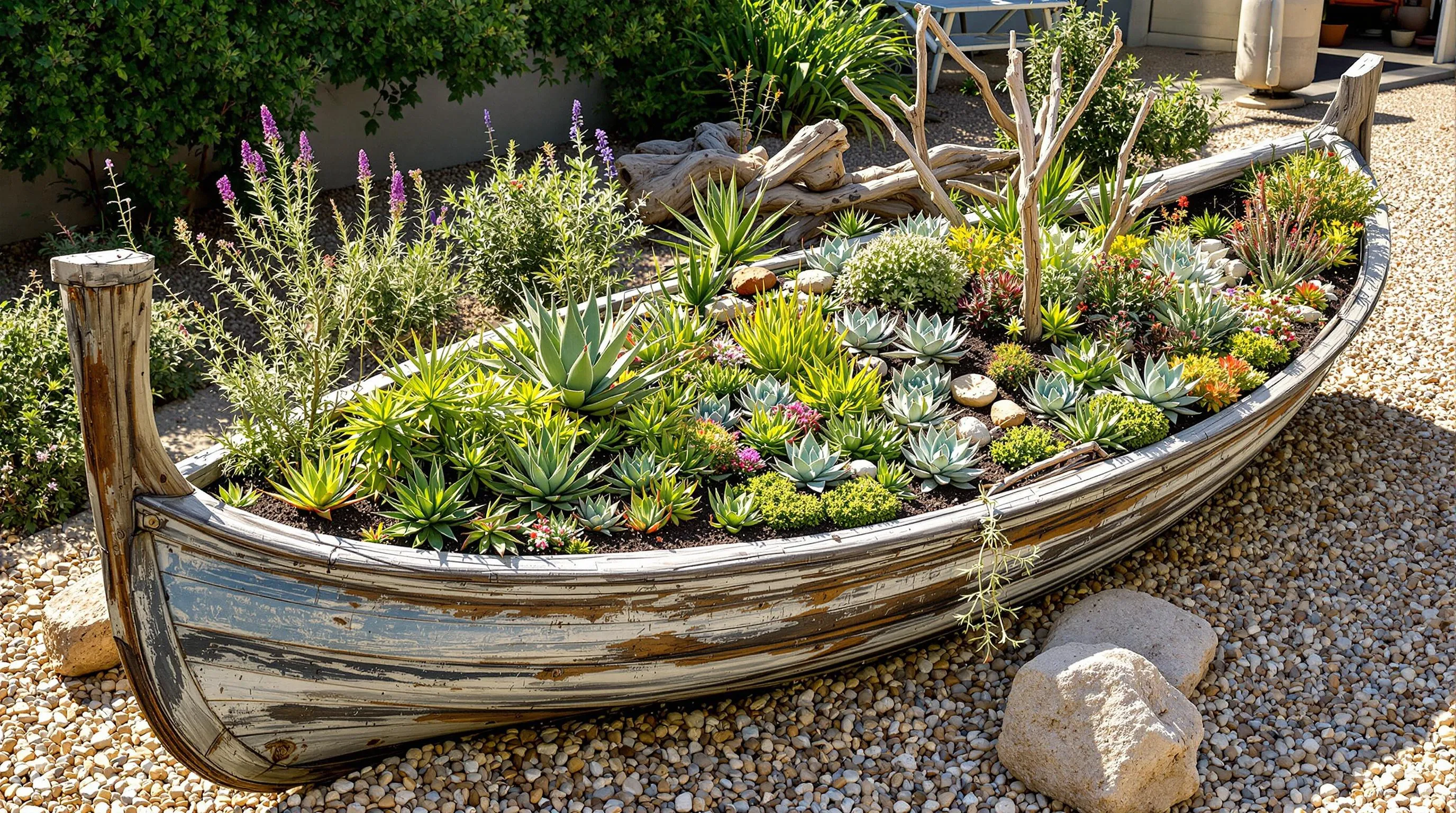
Transform an old fishing boat into a striking succulent garden that captures attention while requiring minimal maintenance. Vintage fishing vessels, with their weathered wood and unique shapes, provide the perfect backdrop for a desert-inspired plant collection. Their shallow depth and open design create ideal growing conditions for succulents, which need excellent drainage and plenty of sun.
Desert Landscapes in Maritime Vessels
Create a stunning contrast by combining nautical history with desert aesthetics in your repurposed boat garden. Fill the bottom of your vintage fishing boat with a layer of gravel topped with cactus soil to ensure proper drainage. Arrange larger succulents like agave or large echeverias near the center to serve as focal points, then cascade smaller varieties like sedum and sempervivum toward the edges. Incorporate driftwood, sea glass, and small river rocks to bridge the maritime-desert theme. Position your boat in the sunniest part of your garden, slightly elevated at one end to prevent water pooling. This unexpected pairing of oceanic vessel and desert plants creates a conversation piece that stands out from traditional garden designs.
Low-Maintenance Plant Selection for Boat Gardens
Choose drought-tolerant succulents that thrive in the challenging conditions of a boat garden. Opt for varieties like jade plants, aloe vera, and various echeverias that require minimal watering and can withstand temperature fluctuations. String of pearls and burro’s tail create dramatic draping effects over the boat’s sides, improving the visual appeal. Add height with architectural plants like snake plants or pencil cacti positioned at the stern or bow. These hardy selections ensure your boat garden remains vibrant year-round with little intervention. Apply a layer of decorative gravel or crushed seashells as mulch to reduce evaporation and complement the maritime theme. With just occasional watering and seasonal pruning, your fishing boat succulent display will become a low-effort yet high-impact feature in your garden industry.
Constructing a Peaceful Boat Meditation Space
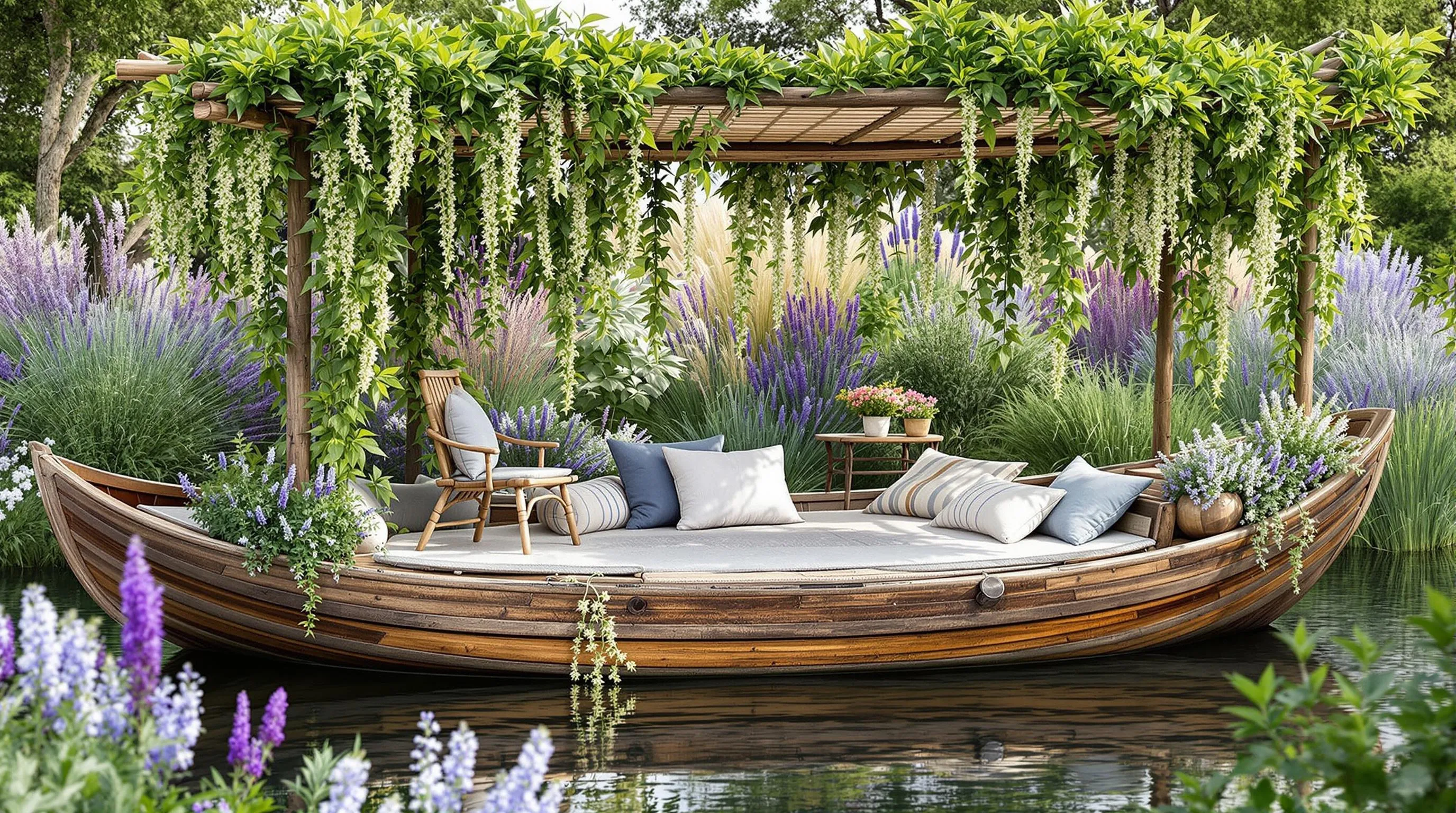
Transform an old boat into your personal outdoor sanctuary where you can practice mindfulness and find tranquility in your garden. A repurposed boat offers a unique, contained space that naturally creates boundaries between you and the outside industry, making it perfect for meditation.
Adding Comfortable Seating and Shade Options
The foundation of your boat meditation space begins with comfortable seating. Install weather-resistant cushions with at least 3-4 inches of padding to create a cozy meditation platform within the boat’s hull. Consider adding a low bench or floor cushions in natural fabrics like cotton or hemp for an authentic zen feel. For shade, attach a simple pergola structure to the boat’s frame using marine-grade hardware, then drape weather-resistant fabric or install a retractable awning. Alternatively, position the boat beneath existing tree coverage or install a bamboo canopy that complements the natural aesthetic while protecting you from harsh sunlight. Add adjustable side panels that can be tied back or closed depending on the weather and time of day to create the perfect meditation atmosphere.
Surrounding Your Boat with Calming Plants
Create a sensory-rich environment around your boat meditation space with strategically placed calming plants. Choose lavender, chamomile, and jasmine to release soothing scents that enhance relaxation during meditation sessions. Position tall ornamental grasses like miscanthus or feather reed grass around the perimeter to create gentle rustling sounds when breeze passes through. For visual tranquility, incorporate blue and purple flowering plants such as hydrangeas, salvias, and catmint that promote peaceful feelings. Add small potted plants of rosemary or lemon balm inside the boat itself for aromatherapy benefits within arm’s reach. Install hanging planters from the boat’s edges with cascading plants like string of pearls or creeping thyme to soften the boat’s lines and create a feeling of being embraced by nature. This plant selection creates a multi-sensory experience that deepens your meditation practice and transforms your repurposed boat into a true garden sanctuary.
Converting a Boat into a Decorative Garden Shed
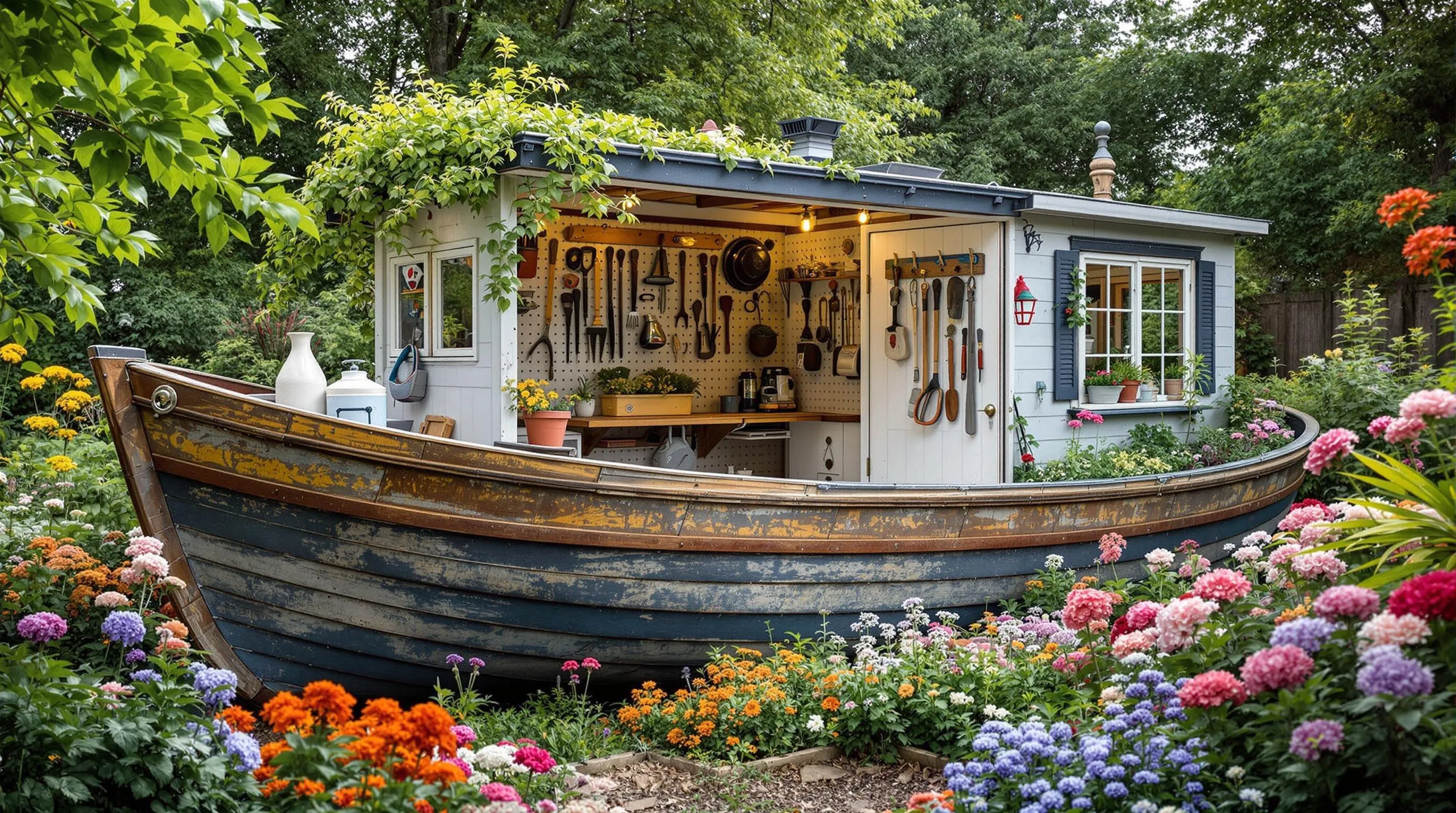
Transform your old boat into a functional and charming garden shed that combines practicality with nautical character. The unique shape and sturdy construction of boats make them perfect candidates for conversion into storage spaces that become focal points in your garden industry. With some creative modifications, your vessel can house all your gardening essentials while adding distinctive style to your outdoor space.
Storage Answers for Garden Tools
Maximize your boat shed’s utility by installing custom storage answers designed to fit its unique contours. Mount pegboards along the interior walls to hang hand tools like trowels, pruners, and cultivators, keeping them visible and accessible. Install adjustable shelving systems that conform to the boat’s curved sides, perfect for storing seed packets, plant markers, and smaller containers. Use the boat’s natural compartments—transform the hull into divided sections for organizing different categories of supplies, and repurpose the bow area for longer items like rakes and shovels. Stackable plastic bins can fit neatly in the boat’s wider sections, offering waterproof storage for soil amendments and plant food. For added convenience, attach tool holders to the exterior of your boat shed for frequently used items, making them easily accessible while working in the garden.
Weatherproofing Your Boat Shed
Ensure your boat shed remains durable and functional year-round by implementing proper weatherproofing techniques. Start by thoroughly sealing any existing cracks or holes with marine-grade caulk, focusing particularly on seams and joints where water might penetrate. Install a pitched roof over your boat using corrugated metal or clear polycarbonate sheets to provide protection from rain and snow while allowing natural light to enter. Treat all wooden surfaces with a high-quality, water-resistant sealant or marine varnish, reapplying annually to maintain protection against moisture and UV damage. Add rubber weatherstripping around any doors or hatches you’ve created to prevent drafts and water infiltration during storms. For boats situated directly on the ground, elevate them slightly on concrete blocks or pressure-treated timber to prevent moisture absorption from soil contact. Consider installing small solar-powered vents to reduce condensation inside the shed, protecting your tools from rust and preventing mildew growth that could compromise both your equipment and the boat’s structure.
Using Small Boats as Movable Container Gardens
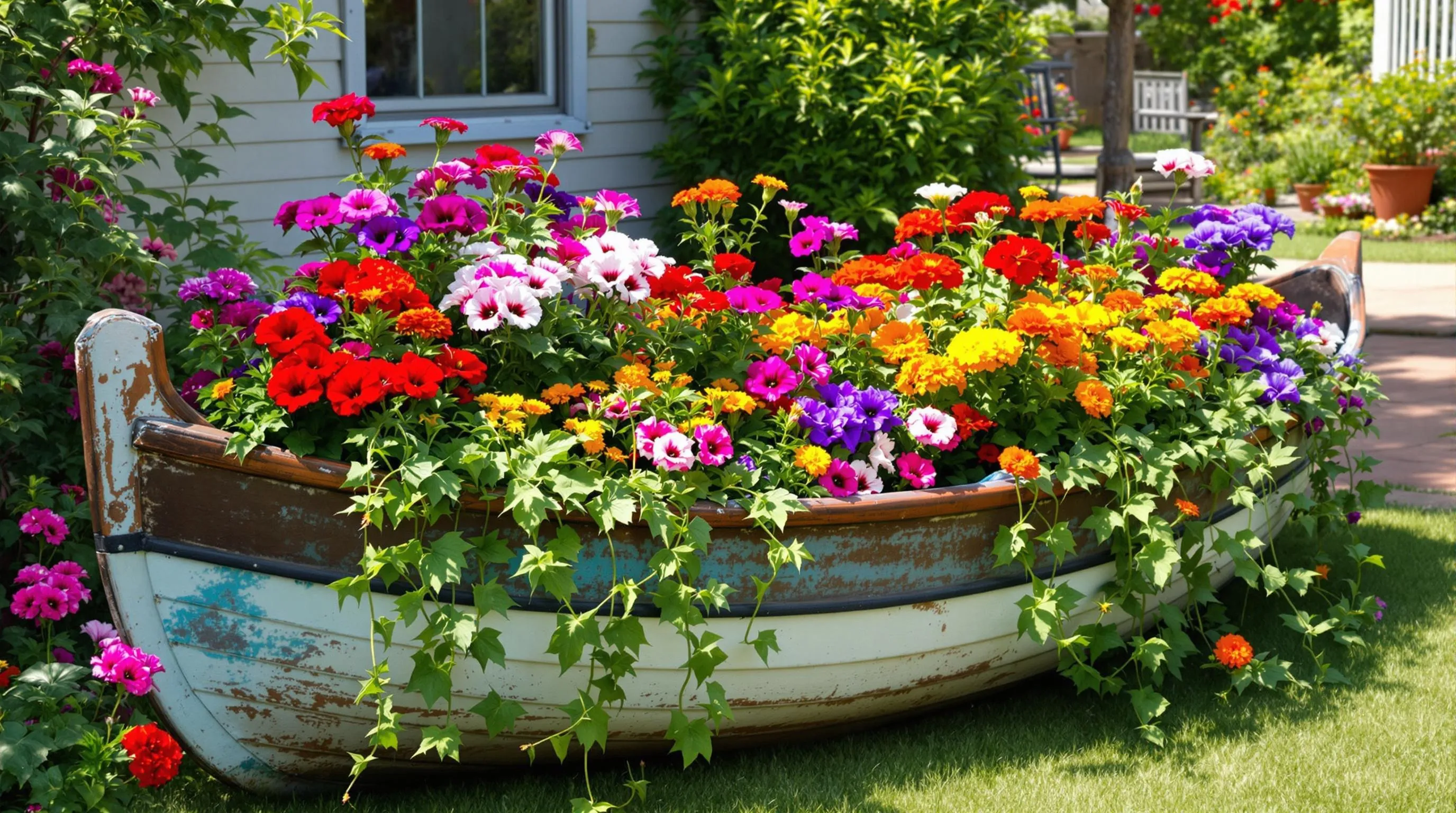
Small boats offer a perfect solution for gardeners who crave flexibility in their outdoor spaces. These portable vessels can be positioned strategically throughout your garden, moved to optimize sunlight exposure, or relocated to serve as seasonal focal points during gatherings.
Plants That Thrive in Portable Boat Planters
Selecting the right plants for your movable boat garden ensures success with minimal maintenance. Drought-tolerant annuals like petunias, marigolds, and zinnias flourish in these containers, providing vibrant color with limited watering needs. Herbs such as basil, thyme, and mint also perform exceptionally well, offering both culinary benefits and pleasant fragrances. For year-round interest, consider ornamental grasses like blue fescue or dwarf fountain grass that maintain their appeal through multiple seasons while withstanding variable conditions. Shallow-rooted vegetables including lettuce, radishes, and bush beans thrive in the limited soil depth of boat planters. When planting, arrange taller specimens at the center or stern of your boat, with cascading varieties like sweet potato vine or trailing lobelia spilling over the sides to enhance the nautical aesthetic.
Seasonal Rotation Ideas for Boat Gardens
Maximize your movable boat garden’s appeal by implementing strategic seasonal rotations. Spring calls for cheerful displays of tulips, daffodils, and pansies that can be moved to highlight areas where the rest of the garden hasn’t yet flourished. Transition to heat-loving summer combinations featuring salvias, lantanas, and trailing verbena that can be positioned in partial shade during intense afternoon heat. For fall, replace spent summer plants with chrysanthemums, ornamental kale, and asters, positioning your boat near entryways or patios where their rich colors can be appreciated. Winter presents opportunities for evergreen arrangements featuring dwarf conifers, holly, and winter heather that can be relocated to protected areas during harsh weather. This rotation system not only maintains visual interest throughout the year but also allows you to refresh soil between plantings, ensuring optimal growing conditions for each seasonal display while extending the functional life of your repurposed boat.
Conclusion: Setting Sail on Your Garden Boat Project
Transforming an old boat into a garden feature offers endless creative possibilities while giving new life to vessels that might otherwise be discarded. Whether you choose a rowboat flower bed a canoe planter or a sailboat herb garden you’ll create a unique focal point that reflects your personality and enhances your outdoor space.
The beauty of boat garden projects lies in their versatility. You can create anything from functional growing spaces to whimsical play areas or peaceful meditation retreats. Each project combines practicality with distinctive charm while supporting sustainable gardening practices.
Ready to embark on your boat upcycling journey? Start by finding the perfect vessel then let your imagination guide your garden creation. Your repurposed boat won’t just grow plants—it’ll cultivate conversations admiration and a deeper connection to your garden space.

